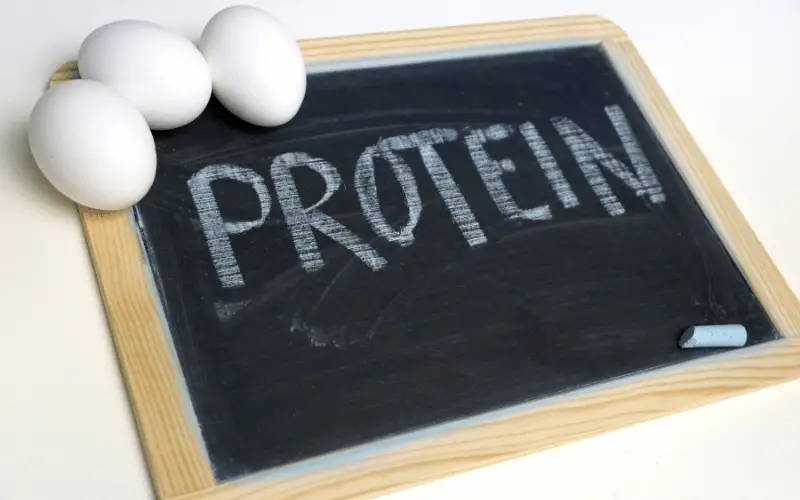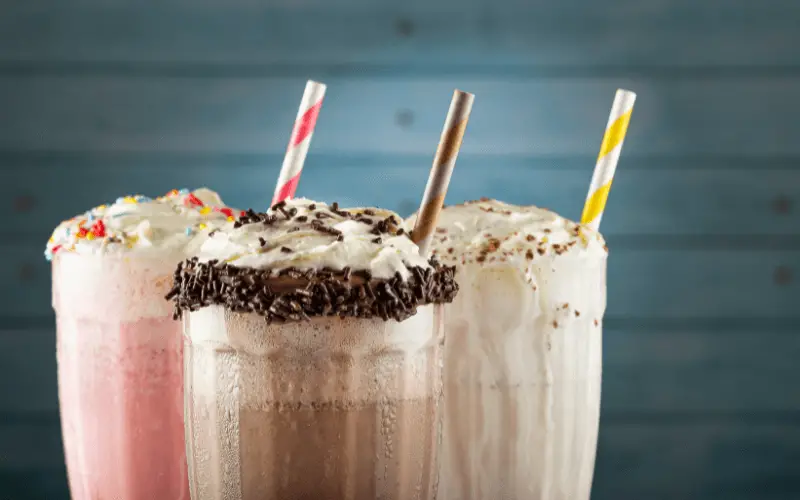A milkshake has some protein in it from the dairy products used to make it. This article will provide examples of the amount of protein in milkshakes.
Protein in Homemade Milkshakes
The two ingredients that are typically in a homemade milkshake and contain protein are milk and ice cream. The amount of protein in a milkshake depends on the the amount used of each product and even the brand/product you opt to consume.
Let’s give you an example of the protein that you might find in a homemade milkshake. For the example, we’ll pretend the milkshake contains 1-1/3 cups of Kroger Deluxe Vividly Vanilla ice cream and 1/2 a cup of 2% milk. We can expect this milkshake to have roughly the following protein content:
| Product | Serving Size | Protein |
|---|---|---|
| Kroger Deluxe Vividly Vanilla Ice Cream | 1-1/3 Cup | 6g |
| Kroger 2% Milk | 1/2 Cup | 4g |
| Total Protein | 10g |
While many people add whipped cream to the top of their milkshake, it has a negligible amount of protein for the serving size that most people consume.
Furthermore, if you use non-dairy ingredients like oat or almond milk, the protein will generally be a bit lower compared to using real dairy.
Protein In Restaurant Milkshakes
The table below reflects a sampling of popular milkshakes found at several restaurants across America.
In summary, restaurant milkshakes contain a varying level of protein, and the amount depends on factors such as the flavor, size, and restaurant. While some milkshakes provide a modest amount of protein, others can be a more substantial source.
The range of protein content in these milkshakes is from 7g to 23g. While the larger serving sizes contain more protein, they also typical have high calories, sugar, and fat content.
Moderation is key when it comes to enjoying milkshakes or any indulgent treats. Consuming them occasionally alongside a well-balanced diet is less likely to have a significant negative impact on health.
| Milkshake | Serving Size | Protein |
|---|---|---|
| Arby’s – Chocolate | Regular | 12g |
| Arby’s – Chocolate | Large | 19g |
| Arby’s – Strawberry | Regular | 11g |
| Arby’s – Strawberry | Large | 15g |
| Burger King – Chocolate | 16 ounces | 13g |
| Burger King – Vanilla | 16 ounces | 12g |
| Burger King – Strawberry | 16 ounces | 12g |
| Burger King – Classic Oreo | 16 ounces | 13g |
| Carl’s Jr. – Vanilla | Regular | 13g |
| Carl’s Jr. – Chocolate | Regular | 13g |
| Carl’s Jr. – Strawberry | Regular | 13g |
| In-N-Out – Chocolate | 15 ounces | 10g |
| In-N-Out – Vanilla | 15 ounces | 10g |
| In-N-Out – Strawberry | 15 ounces | 8g |
| McDonald’s – Chocolate | Small | 12g |
| McDonald’s – Chocolate | Medium | 15g |
| McDonald’s – Chocolate | Large | 18g |
| McDonald’s – Vanilla | Small | 10g |
| McDonald’s – Vanilla | Medium | 12g |
| McDonald’s – Vanilla | Large | 17g |
| McDonald’s – Strawberry | Small | 10g |
| McDonald’s – Strawberry | Medium | 13g |
| McDonald’s – Strawberry | Large | 19g |
| Shake Shack – Chocolate | Mini | 8g |
| Shake Shack – Chocolate | Regular | 16g |
| Shake Shack – Vanilla | Mini | 9g |
| Shake Shack – Vanilla | Regular | 18g |
| Sonic – Chocolate | Mini | 7g |
| Sonic – Chocolate | Small | 11g |
| Sonic – Chocolate | Medium | 14g |
| Sonic – Chocolate | Large | 22g |
| Sonic – Vanilla | Mini | 7g |
| Sonic – Vanilla | Small | 12g |
| Sonic – Vanilla | Medium | 15g |
| Sonic – Vanilla | Large | 23g |
Recommended Protein Intake

For a general recommendation of protein intake, Harvard Health recommends 0.36 grams of protein per pound of body weight for adults. This may be higher or lower for some people because of activity level, pregnancy, and other factors.
A person who is 200 pounds would consume 72 grams of protein daily based on the recommendation outlined by Harvard Health. The math is 200 x 0.36 = 72 grams of protein.
A milkshake will certainly help you inch closer to your protein intake goals but it should not viewed as a healthy food. There are countless other foods that are better for you that a packed with protein such as various meats, plain milk, Greek yogurt, nuts, protein smoothies, soy, eggs, beans, and cheese.
Conclusion
A milkshake does contain protein, primarily from the milk and ice cream. While it may not be as protein-packed as a protein shake, it can still contribute to your daily protein intake.
As with any dessert, moderation is key, and being mindful of the overall nutritional content ensures that your sweet treat aligns with your health and wellness goals.

